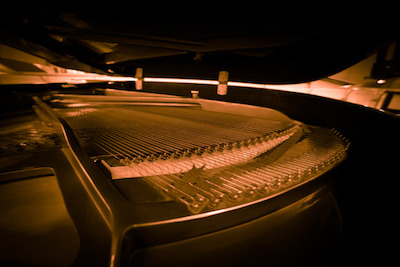The modern day piano comprises many different things:
A keyboard made of 88 wooden keys covered in plastic. Black keys make up sharps and flats and are narrower and offset back from the white keys.
A mechanism called the action that provides for hammers to strike the strings when the keys are pushed.
All 230 strings are corresponding to individual keys to produce sound when they are struck. Strings are struck in groups of two or three to produce sound. 
A pinblock is used for tensioning and tuning individual strings.
The soundboard is created from wood to withstand vibration when the strings are struck. Vibrations are coupled to the soundboard via the bridge, a curved piece of wood and metal that serves as the displacement node for the vibrations.
During the action process, when a note is played, the action lifts the damper felts from the strings so they can resonate when struck. The string will be struck by the hammer that is determined by how hard and how quickly the key was struck. The return of the hammer occurs immediately after the strike so as not to interfere with the vibrating strings.
Thinner, shorter strings are used to produce higher sounds, with the strings thickening for the lower sounds. Two strings typically are used for upper notes, with two strings used to create lower sounds.
With all of these pieces and action occurring all at once, things can go wrong to impact the sound quality.
Inharmonicity – piano strings can be “off” by as much as one half-tone, with this changing over time. If one plays two notes an octave apart, the inharmonicity of the second octave will cause the sound to be “off” to a listener. To “solve” this problem, octaves are stretched, meaning that a note up an octave will be tuned slightly more to the frequency of the octave below. This ensures you “hear” the sound correctly.
Aging – piano hammers are covered with felt, with the purpose being to spread out the impact of the hammer strike. These felts dry out, harden, and disintegrate over time. This serves to emphasize a decreasing quality of sound.
Polarization – pianos are never a perfect instrument. The mechanism changes all the time. And while the action is built with vertical motion, eventually horizontal motion occurs as well, throwing the sound “off.”
Think your piano isn’t producing the proper sound? Call us today.

